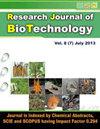Molecular Characterization of Alpha-Amylase of Aspergillus flavus and Aspergillus oryzae: An In Silico Study
IF 0.2
Q4 BIOTECHNOLOGY & APPLIED MICROBIOLOGY
引用次数: 0
Abstract
Alpha amylases (EC 3.2.1.1.) hydrolyze polysaccharides like starch and glycogen to create oligosaccharides of different sizes by random cleavage of internal 1, 4-glucosidic linkages. These enzymes are produced by many different bacteria and fungi. In this investigation, α-amylase from Aspergillus flavus and Aspergillus oryzae was taken into consideration. Amino acid sequences and protein structure were retrieved from databases. Sequences of Aspergillus oryzae possess a high number of charged residues whereas Aspergillus flavus have a higher abundance of uncharged polar and hydrophobic amino acid residues. 3 common superfamilies were observed between both species. The alignment of sequences showed their similar conservative nature. Non-covalent intra-protein interactions like the salt bridge, aromatic-aromatic interactions, aromatic-sulfur interactions and cation-pi interactions helped to increase the stability of α-amylase of Aspergillus oryzae. The tunnels and cavities also help to increase the functionality and catalytic activity of α-amylase. This study will also be helpful for protein engineering.黄曲霉和黑曲霉α-淀粉酶的分子特征:硅学研究
α-淀粉酶(EC 3.2.1.1.)水解淀粉和糖原等多糖,通过随机裂解内部的 1,4-葡糖苷键,生成不同大小的寡糖。这些酶由许多不同的细菌和真菌产生。本次研究考虑了黄曲霉和黑曲霉中的α-淀粉酶。从数据库中检索了氨基酸序列和蛋白质结构。黑曲霉的序列中含有大量带电残基,而黄曲霉的序列中则含有较多不带电的极性和疏水氨基酸残基。在这两个物种之间发现了 3 个共同的超家族。序列比对结果表明它们具有相似的保守性。盐桥、芳香族-芳香族相互作用、芳香族-硫相互作用和阳离子-π相互作用等非共价蛋白质内相互作用有助于提高黑曲霉α-淀粉酶的稳定性。隧道和空腔还有助于提高α-淀粉酶的功能和催化活性。这项研究也将有助于蛋白质工程。
本文章由计算机程序翻译,如有差异,请以英文原文为准。
求助全文
约1分钟内获得全文
求助全文
来源期刊

Research Journal of Biotechnology
BIOTECHNOLOGY & APPLIED MICROBIOLOGY-
CiteScore
0.60
自引率
0.00%
发文量
192
期刊介绍:
We invite you to contribute Research Papers / Short Communications / Review Papers:
-In any field of Biotechnology, Biochemistry, Microbiology and Industrial Microbiology, Soil Technology, Agriculture Biotechnology.
-in any field related to Food Biotechnology, Nutrition Biotechnology, Genetic Engineering and Commercial Biotechnology.
-in any field of Biotechnology related to Drugs and Pharmaceutical products for human beings, animals and plants.
-in any field related to Environmental Biotechnolgy, Waste Treatment of Liquids, Soilds and Gases; Sustainability.
-in inter-realted field of Chemical Sciences, Biological Sciences, Environmental Sciences and Life Sciences.
-in any field related to Biotechnological Engineering, Industrial Biotechnology and Instrumentation.
-in any field related to Nano-technology.
-in any field related to Plant Biotechnology.
 求助内容:
求助内容: 应助结果提醒方式:
应助结果提醒方式:


